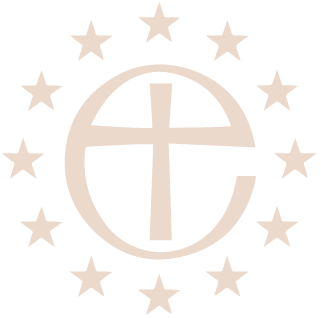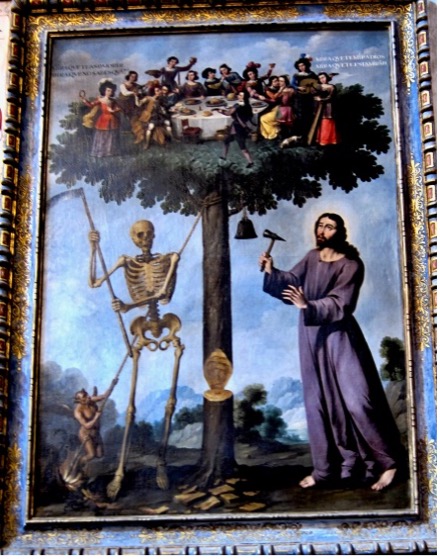
Sermon preached for the congregation at Thessaloniki on the Third Sunday of Advent – 12 December 2021: Zephaniah 3, 14-end; Luke 3, 7-18
Fr Leonard Doolan
I begin by recognizing that today is the feast day of St. Spiridon, who is the patron saint of the island of Corfu. When we had our Archdeaconry Synod in Corfu in October I had the privilege of attending a Holy Liturgy in St. Spiridon Church in Corfu Town, where his remains are laid, and the presiding Orthodox priest was my friend Archimandrite Ignatios Soteriadis. This church has a palpable sense of holiness, but yet of easy accessibility, and the local people and shop keepers just wander in and out of the holy temple, as if Spiridon were among them as a friend and neighbour. Those who have gathered in Thessaoloniki this morning have are looking at an icon of St. Spiridon on the holy table.
We make our way through Advent with all the rich themes and images of this holy season – and we are forced to sort things out in our hearts, minds and lives by the scriptures appropriate to this season, and to the challenge of these images and themes – and we get a second chance to encounter John the Baptizer – who stands for no nonsense. Now there is a theme in itself!
Let’s consider a couple of the images first. Last week, when we had our first reflection on John the Baptizer’s witness, I mentioned the axe that we sometimes see in Orthodox icons of the Baptism of Christ. That is the very scripture passage from St. Luke’s gospel this morning.
After last week a friend of mine responded to my sermon by sending through a very graphic icon that illustrates this biblical image. I share it now for those who have access to the printed version of the sermon – either on paper or on the website. Those who have the pre-recorded version can find the picture there.
This picture, set in Segovia in Spain in the 17th century shows Christ having driven a wedge into the trunk of the tree. Above in the foliage of the tree we see a decadent banquet – laid out with extravagant foods on a table surrounded by elegantly dressed, well to do people, no doubt living in a bubble of wealth, power, riches, corruption and exploitation. Such people, who are representing the bourgeoisie who have the power of life or death for so many people, but they are oblivious of the judgement that is about to befall them. With the axe that has weakened the tree to within an inch of toppling, Christ is about to toll the bell, and beside him the skeletal figure of death, scythe in hand, is about to strike.
Shocking, extreme, deeply uncomfortable – yes, all these things and more, but the symbolism is pure Advent; it is illustrating vividly for us the message of the Baptizer – Repent and believe, for John will baptize with water, but he is the precursor, the Prodromos of the one who will baptize with the Holy Spirit and with fire.
A second image emerges from this gospel text. This is that of the winnower. In some Orthodox icons of the Synaxis of St. John the Forerunner, Christ is shown holding the winnowing fork – it is with this that he will separate the wheat from the chaff.
In these pre-Christmas weeks when our culture focuses on Christmas trees, glorious seasonal shop-window displays, and hastily arranged lunches or dinners with people we want to spend some time with before the Christmas holidays, or wracking our brains about what to buy ‘Uncle Spiro’ for his present, we have this counter-cultural, powerful and soul searching messaging from John.
It is not at all soothing or comforting – and it couldn’t be back then, and it can’t be now, and it won’t be in the future. Advent is a time when we have to stop short and give serious consideration to our values, our practices, our attitudes and our lives. So much of the climate change agenda is a challenge about change – not trade-offs between countries; not offsetting carbon footprints through some carefully argued fine points of detail; not some sort of transactionalism that can make things good between us and with Creation – Christian language speaks of Covenant not of secular transaction; but ACTUAL change.
Biblical language, the language we use week by week in our liturgy, calls this repentance – metanoia in John the Baptizer’s language. The repentance that is called for in John’s messaging is not about ‘saying sorry’ to God because we lost our temper with someone earlier in the week, or because we fell out with someone over this or that issue – but rather it is about changing our lives, changing our lives against the background of living in a new kingdom – the Kingdom of God; the Kingdom that is announced in the birth of a child in a manger in Bethlehem. It is a lovely familiar picture, but it is a world changing birth of a baby, and a life changing birth for you and me.
As I get older and nearer the end of ministry as a priest I look back and reflect on the changes I have seen – in the world, of course, but also in the church. There have been some wonderful developments, such as the ordination of women as bishop, priest and deacon; there has been a commitment to try to understand issues in human sexuality, despite the complexities of this, there have been some fine initiatives in re-focussing the church towards being outward looking, welcoming, and inclusive; and, like a breath of fresh air blowing the church there has been the revision of our liturgy – how we worship, and how the way we worship reflects our beliefs, our doctrine, all of which remains the same ancient faith of the church, but expressed afresh for a new generation.
However, some things have not been lost, but somewhat hidden because they are perhaps less attractive – more difficult to sell to curious searchers, or new believers. One such ‘oublier’ , hidden thing, forgotten thing, is God’s judgement.
Advent used to be a time for preaching, every year, on four themes. We used to call them ‘The Four Last Things’ because they orientated us towards the End Times, or Eschaton. These themes are Death, Judgement, Heaven and Hell. At least one of them seems to be attractive still, but the Advent scriptures remind us every year that we can’t escape from these huge themes – realities of the Christian revelation – which is why we are so grateful for the preaching of John the Forerunner.
I suspect the unpopularity of the Four Last Things, and the preaching that surrounds them, is that we have forgotten what the End Time is like. We associate it with the catastrophic effects of virus, of global warming, and those terrifying – yes terrifying – realities that face humanity now. This is not helped by those literalists who interpret such phenomena as punishment from God.
So let’s try to re-orientate the message this morning. In Christian theology the End Times are not about closure and collapse, destruction and disaster, but about fulfilment, about the vision of a Kingdom made real in Jesus Christ – he is the Alpha and the Omega, the Beginning and the End, but he is equally the End and the Beginning. Jesus is not a chronological time-line, or the first letter of a Greek alphabet and the last letter of a Greek alphabet – he is the Word of God, the LOGOS, who dwells among us, full of grace and truth (John 1, 14).
We’ll be reading that soon in our churches or our homes – but its reality, if it is to be of any substantial value to us in life – can only be discovered truly when we reflect on the messaging of John the Baptizer who introduces the ‘farm-yard implements’ of the axe and the winnowing fork. In the birth of a baby there is an end – the old order has passed away – and a beginning, ‘Behold I am making all things new’ (Revelation 21, 5).
In his recently published book, Looking East in Winter, (Bloomsbury 2021) Rowan Williams reflects on words by the French Orthodox theologian Olivier Clement, when he refers to the ‘end already present’ referring to Christ. He goes on ‘And the prophetic vision is not only of the End in our midst, but specifically the vision of all human flesh and every human face with the amazed attention that arises from the fact of God having become flesh and face.’ (p 145).
This, my friends, is what Christmas is. This is what comes into our midst in the crib and on the cross. “Christ has died, Christ is risen, Christ will come again”. However – we need to hear clearly every year the voice of this great prophet, St. John the Forerunner, and his message for us to prepare, to get ready, to repent, to be alert, awake and most of all be full of hope and expectation, for the coming of our Saviour, and the message of the angel “Do not be afraid; for see – I am bringing you good news of great joy for all the people’. (Luke 2, 10)



No Comments